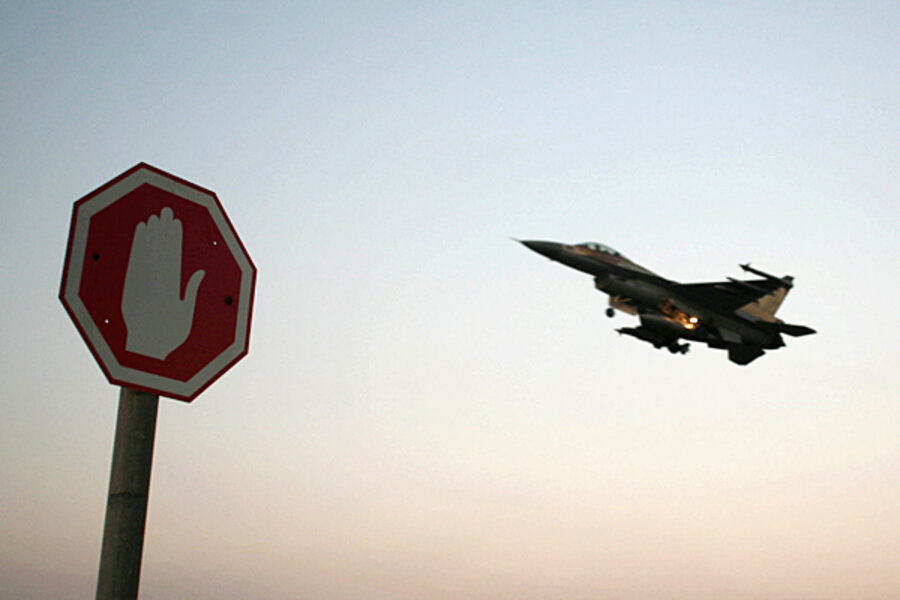Israeli strike indicates Syria, Hezbollah may have crossed its 'red line'
Loading...
| Beirut, Lebanon
Israeli jets reportedly carried out an unprecedented airstrike along the Lebanon-Syria border today against an arms convoy carrying advanced anti-aircraft missiles to the Lebanese Shiite militant group Hezbollah.
If the alleged arms shipment is confirmed, it would be a significant development that crosses Israel's repeated "red line" regarding the transfer of advanced air defense systems to Hezbollah.
The convoy was carrying SA-17 "Grizzly" mobile medium-range anti-aircraft missiles, according to the Associated Press, which quoted Israeli and US officials. The location of the attack remained unclear, although reports said it occurred on Syrian territory close to the border with Lebanon.
Since 2006, when Hezbollah and Israel fought a month-long war, the Lebanese group has steadily expanded its arsenal, both in size and capabilities, in preparation for a possible conflict with the Jewish state.
The Lebanese Army acknowledged in a statement that three waves of Israeli aircraft violated Lebanese airspace between 4:30 p.m. yesterday and 7:55 a.m. today. Israeli jets and reconnaissance drones stage flyovers above Lebanon on a near daily basis – the white contrails made by the passing aircraft are a common sight on clear days – but a Western diplomat said that there had been a “substantially unusual and very high level of air activity in the past two days."
Lebanese security sources denied all knowledge of an airstrike along the border and there were no reports in Lebanese media this morning of any such incident.
Israeli Prime Minister Benjamin Netanyahu last week gathered Israel's top security chiefs to discuss the threat posed by the war in Syria, in particular the possibility of Syria’s chemical weapons arsenal falling into the hands of radical groups.
Syria is believed to have one of the largest chemical weapons stockpiles in the world, including VX and Sarin nerve gas and blister agents which can be loaded into rocket warheads.
“We have been monitoring for a long time the possibility that chemical weapons will fall into the hands of extremist rebels, or worse, into the hands of Hezbollah,” Silvan Shalom, Israel’s deputy premier said on Jan. 27. Shalom added that if Hezbollah was to acquire chemical weapons, it would be “a crossing of all red lines that would require a different approach, including even preventative operations… The concept, in principle, is that this [transfer] must not happen.”
Over the weekend, Israel deployed two batteries of the Iron Dome anti-missile system near Haifa, close to the border with Lebanon, another indication of Israeli concern at the possibility of Hezbollah acquiring advanced missiles.
If Israeli aircraft did intercept a Hezbollah arms convoy last night, there are a limited number of places along the border where the attack could have occurred. Hezbollah controls a lengthy stretch of the rugged barren mountains that mark the eastern border and a small length of the northern border, both of which are believed to have been used in the past to bring in weapons. Hezbollah traditionally remains tight-lipped on how weapons transfers are made, although it does not deny possessing a formidable arsenal.
“We do not fight our enemies with swords made of wood,” quipped Hezbollah chief Sheikh Hassan Nasrallah in 2007 when admitting in a speech that “all kinds and quantities” of weapons were being acquired by his party.
The Israeli government considers Hezbollah’s acquisition of chemical weapons and advanced anti-aircraft missiles a “red line” that would justify an airstrike. But targeting a Hezbollah arms convoy would be an unprecedented act by Israel and would risk raising tensions along the Lebanon-Israel border, which has remained calm since the month-long war between the two foes in 2006.
Last year, Syria confirmed that it had received a number of SA-17 batteries from Russia as part of a deal signed several years ago. Two batteries were reportedly operational last April along the Lebanon-Syria border. The SA-17 has a range of 30 miles and can hit multiple targets at 40,000 feet, putting all manner of Israeli aircraft, from reconnaissance drones to jets, at risk in Lebanese or adjacent airspace.
Little is known of Hezbollah's anti-aircraft capabilities. The only air defense missiles employed by the group in the past were relatively antiquated SA-7 shoulder-fired systems, which pose little threat to Israeli military aircraft. It is believed that Hezbollah possesses the SA-18 grouse, a more advanced version of the SA-7. In 2010, it was reported that Hezbollah militants were being trained in Syria on the SA-8 Gecko mobile short-range system, although none at the time were thought to have been transferred to Lebanon.





